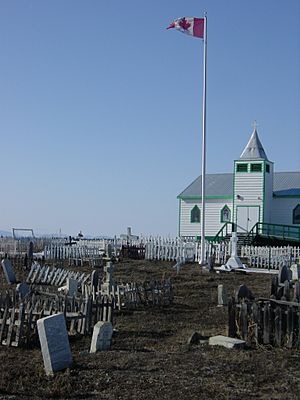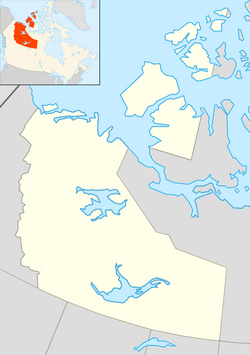Fort McPherson, Northwest Territories facts for kids
Quick facts for kids
Fort McPherson
Teetł'it Zheh
The heart of the Gwichʼin
|
|
|---|---|

A wooden church in Fort McPherson, NWT
|
|
| Motto(s):
"Take what you need"
|
|
| Country | Canada |
| Territory | Northwest Territories |
| Region | Inuvik Region |
| Constituency | Mackenzie Delta |
| Census division | Region 1 |
| Hamlet | 1 November 1986 |
| Area | |
| • Land | 53.83 km2 (20.78 sq mi) |
| Elevation | 43 m (141 ft) |
| Population
(2021)
|
|
| • Total | 647 |
| • Density | 12.0/km2 (31/sq mi) |
| Time zone | UTC−07:00 (MST) |
| • Summer (DST) | UTC−06:00 (MDT) |
| Canadian Postal code |
X0E 0J0
|
| Area code(s) | 867 |
| Telephone exchange | 952 |
| - Living cost (2018) | 162.5 |
| - Food price index | 162.8 |
| Website | www.fortmcpherson.ca |
| Sources: Department of Municipal and Community Affairs, Prince of Wales Northern Heritage Centre, Canada Flight Supplement 2018 figure based on Edmonton = 100 2019 figure based on Yellowknife = 100 |
|
| Official name: Fort McPherson National Historic Site of Canada | |
| Designated: | 1969 |
Fort McPherson (Gwich'in: Teetł'it Zheh [tʰeː.tɬʼɪtʰ ʒɛh], at the head of the waters) is a hamlet located in the Inuvik Region of the Northwest Territories, Canada. It is located on the east bank of the Peel River and is 121 km (75 mi) south of Inuvik on the Dempster Highway.
The First Nations people who make up the majority are Gwich'in (Teetł'it Gwich'in) and the two principal languages spoken are Gwichʼin and English. Originally the site of a Hudson's Bay Company post the community was named for Murdoch McPherson.
Most people have vehicles and regularly make trips to either Inuvik, or Whitehorse, Yukon.
History
Fort McPherson was the starting point of Francis Joseph Fitzgerald's famous tragic journey of "The Lost Patrol". All four men on the Patrol, including Fitzgerald, were buried at Fort McPherson on 28 March 1911. In 1938, the graves were cemented over into one large tomb (to the right of the flag pole in above image), with cement posts at the four corners connected by a chain. In the centre is a memorial to the Royal Northwest Mounted Police Patrol of 1910.
National Historic Site
In 1969, the area comprising the boundaries of the community of Fort McPherson, as it was mapped in 1898, was designated a National Historic Site of Canada, in recognition of the fact that the site had served as the principal Hudson's Bay Company trading post in the MacKenzie Delta region for over 50 years, and had been the first North-West Mounted Police post in the Western Arctic.
Transportation
Fort McPherson is accessible by road all year from Dawson City and Whitehorse, Yukon, with the exception of spring break-up and fall freeze-up on the Peel River. The community also has access to Inuvik via the Dempster Highway and crosses the Mackenzie River at Tsiigehtchic.
There is also a small airport at Fort McPherson, Fort McPherson Airport, that has seasonal flights to Inuvik (Mike Zubko) Airport on Aklak Air when the road across the Peel is closed. The former Fort McPherson Water Aerodrome was listed as closed in the 15 March 2007 Canada Flight Supplement.
Demographics
In the 2021 Census of Population conducted by Statistics Canada, Fort McPherson had a population of 647 living in 255 of its 318 total private dwellings, a change of -7.6% from its 2016 population of 700. With a land area of 53.83 km2 (20.78 sq mi), it had a population density of 12.0/km2 (31/sq mi) in 2021.
In the 2016 Census 695 people identified as Indigenous, 610 as First Nations, 15 as Métis, 20 as Inuit or Inuvialuit, 10 giving multiple or other aboriginal responses and 40 non-Aboriginal.
| Federal census population history of Fort McPherson | ||
|---|---|---|
| Year | Pop. | ±% |
| 1976 | 710 | — |
| 1981 | 623 | −12.3% |
| 1986 | 760 | +22.0% |
| 1991 | 759 | −0.1% |
| 1996 | 878 | +15.7% |
| 2001 | 773 | −12.0% |
| 2006 | 776 | +0.4% |
| 2011 | 792 | +2.1% |
| 2016 | 700 | −11.6% |
| 2021 | 647 | −7.6% |
| Source: Statistics Canada |
||
| Annual population estimates | |||||||||||||||||||||||||||||||||||||||||||||||||||||||||||||||||||||||||||||||
|---|---|---|---|---|---|---|---|---|---|---|---|---|---|---|---|---|---|---|---|---|---|---|---|---|---|---|---|---|---|---|---|---|---|---|---|---|---|---|---|---|---|---|---|---|---|---|---|---|---|---|---|---|---|---|---|---|---|---|---|---|---|---|---|---|---|---|---|---|---|---|---|---|---|---|---|---|---|---|---|
|
|
||||||||||||||||||||||||||||||||||||||||||||||||||||||||||||||||||||||||||||||
| Sources: NWT Bureau of Statistics (2008 - 2019), NWT Bureau of Statistics (2001 - 2017) | |||||||||||||||||||||||||||||||||||||||||||||||||||||||||||||||||||||||||||||||
Climate
Fort McPherson experiences a subarctic climate (Köppen climate classification Dfc). The highest temperature ever recorded in Fort McPherson was 35.1 °C (95.2 °F) on 6 August 2024. The coldest temperature ever recorded was −55.6 °C (−68.1 °F) on 14 January 1894.
| Climate data for Fort McPherson (Fort McPherson Airport) Climate ID: 2201601; coordinates 67°24′28″N 135°31′57″W / 67.40778°N 135.53250°W; elevation: 35.4 m (116 ft); 1981–2010 normals, extremes 1892–present |
|||||||||||||
|---|---|---|---|---|---|---|---|---|---|---|---|---|---|
| Month | Jan | Feb | Mar | Apr | May | Jun | Jul | Aug | Sep | Oct | Nov | Dec | Year |
| Record high humidex | 9.0 | 7.6 | 8.2 | 15.7 | 28.3 | 38.8 | 34.0 | 35.7 | 27.0 | 24.1 | 4.4 | 4.6 | 38.8 |
| Record high °C (°F) | 8.9 (48.0) |
10.0 (50.0) |
10.6 (51.1) |
16.7 (62.1) |
29.5 (85.1) |
32.0 (89.6) |
33.3 (91.9) |
35.1 (95.2) |
27.2 (81.0) |
24.1 (75.4) |
10.0 (50.0) |
9.0 (48.2) |
35.1 (95.2) |
| Mean daily maximum °C (°F) | −23.8 (−10.8) |
−20.8 (−5.4) |
−14.9 (5.2) |
−4.0 (24.8) |
6.9 (44.4) |
18.5 (65.3) |
20.2 (68.4) |
16.4 (61.5) |
8.4 (47.1) |
−4.0 (24.8) |
−17.2 (1.0) |
−20.8 (−5.4) |
−2.9 (26.8) |
| Daily mean °C (°F) | −27.5 (−17.5) |
−24.9 (−12.8) |
−20.3 (−4.5) |
−9.9 (14.2) |
2.1 (35.8) |
13.0 (55.4) |
15.2 (59.4) |
11.8 (53.2) |
4.6 (40.3) |
−7.0 (19.4) |
−20.5 (−4.9) |
−24.4 (−11.9) |
−7.3 (18.9) |
| Mean daily minimum °C (°F) | −31.1 (−24.0) |
−29.0 (−20.2) |
−25.7 (−14.3) |
−15.7 (3.7) |
−2.7 (27.1) |
7.5 (45.5) |
10.2 (50.4) |
7.2 (45.0) |
0.8 (33.4) |
−9.9 (14.2) |
−23.8 (−10.8) |
−28.1 (−18.6) |
−11.7 (10.9) |
| Record low °C (°F) | −55.6 (−68.1) |
−55.0 (−67.0) |
−48.9 (−56.0) |
−44.4 (−47.9) |
−25.6 (−14.1) |
−6.7 (19.9) |
−1.1 (30.0) |
−6.7 (19.9) |
−19.5 (−3.1) |
−37.5 (−35.5) |
−46.7 (−52.1) |
−50.6 (−59.1) |
−55.6 (−68.1) |
| Record low wind chill | −59 | −57 | −54 | −42 | −33 | −9 | 0 | −5 | −18 | −40 | −50 | −60 | −60 |
| Average precipitation mm (inches) | 14.9 (0.59) |
14.8 (0.58) |
12.7 (0.50) |
10.9 (0.43) |
17.2 (0.68) |
25.5 (1.00) |
46.4 (1.83) |
39.4 (1.55) |
33.1 (1.30) |
37.0 (1.46) |
29.0 (1.14) |
17.0 (0.67) |
297.7 (11.72) |
| Average rainfall mm (inches) | 0.0 (0.0) |
0.0 (0.0) |
0.0 (0.0) |
0.3 (0.01) |
8.2 (0.32) |
25.1 (0.99) |
46.4 (1.83) |
39.1 (1.54) |
25.7 (1.01) |
1.2 (0.05) |
0.0 (0.0) |
0.0 (0.0) |
145.9 (5.74) |
| Average snowfall cm (inches) | 14.9 (5.9) |
14.8 (5.8) |
12.7 (5.0) |
10.6 (4.2) |
9.0 (3.5) |
0.4 (0.2) |
0.0 (0.0) |
0.3 (0.1) |
7.4 (2.9) |
36.4 (14.3) |
29.0 (11.4) |
17.0 (6.7) |
152.5 (60.0) |
| Average precipitation days (≥ 0.2 mm) | 6.4 | 5.1 | 6.0 | 4.1 | 5.2 | 7.0 | 9.9 | 11.3 | 11.0 | 11.8 | 9.9 | 6.8 | 94.3 |
| Average rainy days (≥ 0.2 mm) | 0.0 | 0.0 | 0.0 | 0.2 | 2.5 | 6.9 | 9.9 | 11.3 | 8.8 | 0.8 | 0.0 | 0.1 | 40.4 |
| Average snowy days (≥ 0.2 cm) | 6.4 | 5.1 | 6.0 | 4.0 | 2.9 | 0.2 | 0.0 | 0.2 | 2.6 | 11.2 | 9.9 | 6.7 | 55.1 |
| Source: Environment and Climate Change Canada | |||||||||||||
See also
 In Spanish: Fort McPherson (Territorios del Noroeste) para niños
In Spanish: Fort McPherson (Territorios del Noroeste) para niños



